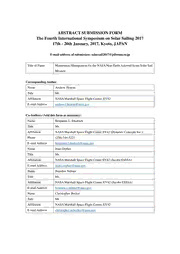
NASA Technical Reports Server (NTRS) 20170001506: Momentum Management for the NASA Near Earth Asteroid Scout Solar Sail Mission PDF
Preview NASA Technical Reports Server (NTRS) 20170001506: Momentum Management for the NASA Near Earth Asteroid Scout Solar Sail Mission
ABSTRACT SUBMISSION FORM The Fourth International Symposium on Solar Sailing 2017 17th - 20th January, 2017, Kyoto, JAPAN E-mail address of submission: [email protected] Title of Paper Momentum Management for the NASA Near Earth Asteroid Scout Solar Sail Mission Corresponding Author Name Andrew Heaton Title Mr. Affiliation NASA Marshall Space Flight Center, EV42 E-mail Address [email protected] Co-Authors (Add this form as necessary) Name Benjamin L. Diedrich Title Mr. Affiliation NASA Marshall Space Flight Center EV42 (Dynamic Concepts Inc.) Phone (256) 544-5221 E-mail Address [email protected] Name Juan Orphee Title Mr. Affiliation NASA Marshall Space Flight Center EV42 (Jacobs-ESSSA) E-mail Address [email protected] Name Brandon Stiltner Title Mr. Affiliation NASA Marshall Space Flight Center, EV42 (Jacobs-ESSSA) E-mail Address [email protected] Name Christopher Becker Title Mr. Affiliation NASA Marshall Space Flight Center, EV42 E-mail Address [email protected] Abstract (about 400 words) The Momentum Management (MM) system is described for the NASA Near Earth Asteroid Scout (NEA Scout) cubesat solar sail mission. Unlike many solar sail mission proposals that used solar torque as the primary or only attitude control system, NEA Scout uses small reaction wheels (RW) and a reaction control system (RCS) with cold gas thrusters, as described in the abstract “Solar Sail Attitude Control System for Near Earth Asteroid Scout Cubesat Mission.” The reaction wheels allow fine pointing and higher rates with low mass actuators to meet the science, communication, and trajectory guidance requirements. The MM system keeps the speed of the wheels within their operating margins using a combination of solar torque and the RCS. The primary actuator for momentum management is the Adjustable Mass Translator (AMT), which moves part of the cubesat bus in order to shift the center of mass (CM) relative to the center of pressure of pressure (CP). The AMT is used to manage torques and momentum about the in-plane body axes of the sail (which align with the booms). The AMT uses a Proportional-Integral (PI) controller on the reaction wheel momentum projected into the X and Y (in-plane) body axes. Steps are taken to reduce the duty cycle of the AMT. Filters are used to smooth the reaction wheel speed measurements so that AMT position commands and smooth. The AMT controller activates when the momentum in each of the X and Y axes reaches a threshold, and deactivates when both the momentum and torque reach deadbands, meaning that the wheels are desaturated and the solar torque has been trimmed out. This results in a system that actuates the AMT during and after slew maneuvers, and otherwise only moves once approximately every 12 hours when maintaining attitude. Figure 1 shows the AMT position and reaction wheel momentum and torques in response to the controller. Residual roll torque (about the normal vector of the sail, Z) will gradually increase the speed of the wheels, much slower than the torque about the in-plane boom axes. The roll torque varies with roll angle when the sun incidence angle is greater than 0 degrees. Above ~20 degrees, the roll torque variation with roll angle will cross zero, allowing it to be trimmed out and managed purely with roll angle control. During portions of the mission when the SIA is less than 20 degrees, RCS will be used. A worst-case estimate of 1x10-7 Nm roll torque for the entire 2.5 year mission duration (not including times when roll control is available) results in a propellant budget of 300 grams. RCS will also be used as a backup to the AMT for all body axes. Figure 2 shows the residual torque about the sail normal (Z) axis when the AMT is in the trim position for a range of sun incidence and clock angles. (a) (b) (c) Figure 1. AMT position (a), reaction wheel body momentum (b), and reaction wheel body torque (c) with 45 degree sun incidence Figure 2. Residual torque about sail normal (Z) over range of sun incidence and clock angles with AMT in trim position
